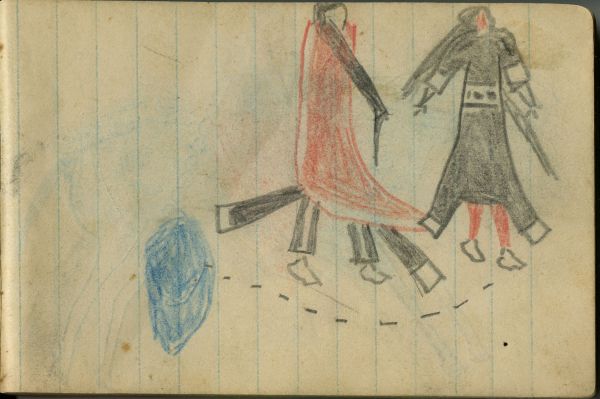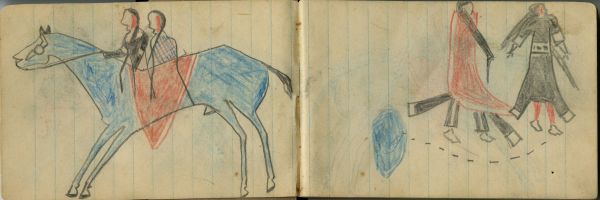COURTING: A Man Courts a Woman as She Returns from Fetching Water
Ethnographic Notes
Horizontal COURTING: A Man Courts a Woman as She Returns from Fetching Water Women were free from chaperones only when they went to fetch water for the family every morning, so references to water (or presence of water buckets) suggests trysts. George Bird Grinnell writes about courtship, a woman would appear unchaperoned "on her way to get wood or water." The man "stepped up beside her, and threw his arms and his blanket around her, quite covering her person with the blanket. Then he held her fast and began to talk with her. If she did not like this, she broke away from him, and he went away from him, and he went away, much mortified; but if she listened to him, he might talk to her for an hour or two--perhaps much longer" (1923: 1, 132). This man in a red robe accosts a woman on her return from her daily chore. The dashes indicate her path from the spring or water source. The woman is on the right. She wears the same dress as the woman in Plate 7: dark stroud cloth with undyed selvedges at cuffs and hem. Here the woman has red facepaint, which suggests she was prepared for the encounter. She also wears the decorated belt of Plate 6. Her hair is extended behind her. Red leggings extend beneath her dress. The man wears a red blanket with a white stripe down the back, a "skunk" blanket, described by Michael Cowdrey as a courting blanket made of "two pieces of white-selvedge trade cloth sewn together. This produced a double-width wrap, with a broad white stripe down the center" (1999: 75). This white stripe runs down his back and resembles the skunk's stripe. See Arrow"s Elk Society Ledger on PILA for examples as well as the Wild Hog-KSHS ledger on PILA for more examples. The man wraps his one visible braid in otter fur, with an end dangling. George Bird Grinnell wrote about the power of skunks: "The skunk possesses power. Doctors used its hide to hold their medicine. Men tied its tail to their horses' tails in war. It is engraved in ornament on the seeds employed by women in gambling, and is painted on robes and lodges" (1923, II, 104) and Michael Cowdrey discusses the association of skunks with warfare, because of the black and white coloring: "Both [badgers and skunks] wear 'war paint' that is black and white" (1999: 210). The man's leggings and breech clout flaps are made of stroud cloth with undyed selvedges used as decorative accent. They are of dark cloth (gray pencil fill). Like the woman, he is well dressed for the encounter.

